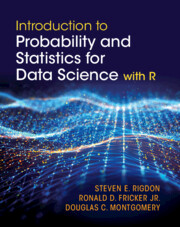Refine search
Actions for selected content:
1835 results in Knowledge Management, Databases and Data Mining

Menopause Transitions and the Workplace
- Theorizing Transitions, Responsibilities and Interventions
-
- Published by:
- Bristol University Press
- Published online:
- 17 December 2024
- Print publication:
- 10 January 2024

Introduction to Probability and Statistics for Data Science
- with R
-
- Published online:
- 13 December 2024
- Print publication:
- 14 November 2024
-
- Textbook
- Export citation
5 - In-Memory Data Processing in Large Data Centers
-
- Book:
- Data Management
- Published online:
- 21 November 2024
- Print publication:
- 28 November 2024, pp 109-121
-
- Chapter
- Export citation
Contents
-
- Book:
- Data Management
- Published online:
- 21 November 2024
- Print publication:
- 28 November 2024, pp vii-x
-
- Chapter
- Export citation
Index
-
- Book:
- Data Management
- Published online:
- 21 November 2024
- Print publication:
- 28 November 2024, pp 279-284
-
- Chapter
- Export citation
7 - GPU for Structured Data
-
- Book:
- Data Management
- Published online:
- 21 November 2024
- Print publication:
- 28 November 2024, pp 167-202
-
- Chapter
- Export citation
1 - Introduction
-
- Book:
- Data Management
- Published online:
- 21 November 2024
- Print publication:
- 28 November 2024, pp 1-16
-
- Chapter
- Export citation
Acknowledgements
-
- Book:
- Data Management
- Published online:
- 21 November 2024
- Print publication:
- 28 November 2024, pp xvii-xviii
-
- Chapter
- Export citation
10 - The Future of Computing: Synergies in Data Management and System Architecture
-
- Book:
- Data Management
- Published online:
- 21 November 2024
- Print publication:
- 28 November 2024, pp 266-269
-
- Chapter
- Export citation
9 - Ray Tracing Hardware in GPUs for Accelerated Computation
-
- Book:
- Data Management
- Published online:
- 21 November 2024
- Print publication:
- 28 November 2024, pp 237-265
-
- Chapter
- Export citation
3 - Main Memory: The Physical Space
-
- Book:
- Data Management
- Published online:
- 21 November 2024
- Print publication:
- 28 November 2024, pp 41-81
-
- Chapter
- Export citation
Frontmatter
-
- Book:
- Data Management
- Published online:
- 21 November 2024
- Print publication:
- 28 November 2024, pp i-iv
-
- Chapter
- Export citation
6 - GPU Computing: A New Algorithm-to-Architecture Interaction
-
- Book:
- Data Management
- Published online:
- 21 November 2024
- Print publication:
- 28 November 2024, pp 122-166
-
- Chapter
- Export citation
Dedication
-
- Book:
- Data Management
- Published online:
- 21 November 2024
- Print publication:
- 28 November 2024, pp v-vi
-
- Chapter
- Export citation
8 - GPU for Spatial Data: A Case Study in Pathology Imaging Applications
-
- Book:
- Data Management
- Published online:
- 21 November 2024
- Print publication:
- 28 November 2024, pp 203-236
-
- Chapter
- Export citation
References
-
- Book:
- Data Management
- Published online:
- 21 November 2024
- Print publication:
- 28 November 2024, pp 270-278
-
- Chapter
- Export citation
4 - Buffer Replacement Algorithms
-
- Book:
- Data Management
- Published online:
- 21 November 2024
- Print publication:
- 28 November 2024, pp 82-108
-
- Chapter
- Export citation
2 - Data Storage: Physical Allocation and Logical Format
-
- Book:
- Data Management
- Published online:
- 21 November 2024
- Print publication:
- 28 November 2024, pp 17-40
-
- Chapter
- Export citation
Preface
-
- Book:
- Data Management
- Published online:
- 21 November 2024
- Print publication:
- 28 November 2024, pp xi-xvi
-
- Chapter
- Export citation

Data Management
- Interactions with Computer Architecture and Systems
-
- Published online:
- 21 November 2024
- Print publication:
- 28 November 2024
